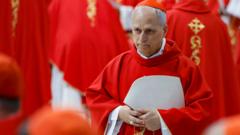Pope Leo XIV, officially Robert Francis Prevost, was welcomed by exuberant crowds chanting "Viva il Papa" upon his announcement as the 267th pope from St Peter's Basilica. This historic election marks him as the first American pontiff, reflecting his long tenure as a missionary in Peru, which earned him ties to Latin America. Born in Chicago in 1955 to immigrant parents, he trained as a priest and dedicated years to serving marginalized communities both in Peru and as a pastor in the U.S., deepening his bonds with diverse populations.
In his inaugural address, Leo XIV expressed gratitude to his predecessor, Pope Francis, and emphasized a collaborative approach in faith. As the former prefect of the Dicastery for Bishops, he held significant influence in advising on key episcopal appointments and is expected to continue advocating for the marginalized, including migrants and those facing environmental challenges.
His choice of the name Leo is particularly significant, as historical Popes Leo have made noteworthy contributions to social justice. Prevost highlighted his immigrant roots and Catholic upbringing, illustrating a deep understanding of interconnectedness amid societal changes. Experts suggest that his papacy will likely carry forward Pope Francis' commitment to the environment and support for inclusive practices, although speculation remains about his potential differences, particularly regarding LGBTQ+ issues.
Pope Leo XIV has previously supported progressive initiatives, including women’s roles within church governance and striving for tangible solutions to climate change. As he assumes leadership, the gaze of both the faithful and critics will be keenly focused on his policies, speeches, and how he navigates the complexities of modern Catholicism.


















